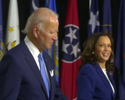For all his ugliness and buffoonery, Donald Trump got some big things right, politically and practically, that Joe Biden will undo at his own peril. Almost all of Trump’s wins, abroad and at home, have one thing in common: They focused on most Americans achieving broader prosperity and not only the best-off. read more »
Washington DC
The Big Thing That Trump Got Right and Biden Can’t Afford to Screw Up
- Login to post comments
Why Trump's America Will Live On
Like many, if not most Americans, I am somewhat relieved to see the petulant, nasty and sometimes clearly unhinged Donald Trump leave the White House. Yet for all his antics and vitriol, Trump has left a legacy that will be difficult to ignore and, given the dispensation of his opponents, could shape the future for the next decade. read more »
- Login to post comments
The Real Fascist Threat Was Never Trump – It's Corporate Power
We cannot hope to have a functional democracy when property and information are controlled by a small number of companies tightly allied with political power. read more »
- Login to post comments
Watching the Sausage Get Made
Amtrak ridership is down by 87 percent, so Amtrak needs a $2.9 billion rescue from Congress, the company’s executive vice president, Stephen Gardner, told a congressional subcommittee yesterday. Transit ridership is down 70 to 90 percent, added American Public Transportation Association president Paul Skoutelas, so the transit industry wants a $32 billion bailout from Congress. read more »
- Login to post comments
After Election, We'll Still Be 'Forgotten Man'
Regardless of your politics, you have to agree that Donald Trump remembered the “forgotten man” and woman. Yet that particular class of American still seems forgotten, frankly – or deliberately overlooked. And that doesn’t bode well for Flyover Country no matter what happened in the election. read more »
- Login to post comments
The Grand New Party
Given the likely defeat of President Donald Trump, a functionally headless Republican Party is destined for a period of reflection. Trump himself, for all his rudeness and often unnecessary, divisive rhetoric, has transformed the Republican Party from being a bastion of the establishment to a voice for America’s working and middle class. read more »
- Login to post comments
The Real Winners
Progressive ideologues often like to evoke the idea that they speak “truth to power,” but this year it’s their leaders who are consolidating their clout. read more »
- Login to post comments
America's Center Needs to Make Itself Heard
The intensity surrounding the coming election, the nastiness of the debates and general rhetoric, and the unending protests and rallies and even regattas in support of President Trump paint a picture of a very polarized nation. Our divisions are real—and concerning—but some context is needed. read more »
- Login to post comments
Democrats' Energy Dilemma
The biggest challenge facing a putative first-term Joe Biden administration and the Democratic Party may lie with energy policy, where gentry and green wishful thinking confront the daily realities of millions of middle- and working-class Americans. read more »
- Login to post comments
Biden's Quote: "We're Not Getting rid of fossil fules for a long time, probably 2050"
Former V.P. Joe Biden’s climate policies and the litigation and regulation grandiloquence are toward the energy industry that was virtually non-existent before 1900. Today, America has only about four percent of the world’s population (330 million vs. 8 billion). read more »
- Login to post comments






















